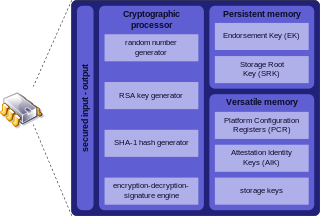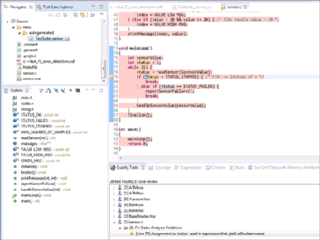
The Object Management Group (OMG) is a computer industry standards consortium. OMG Task Forces develop enterprise integration standards for a range of technologies.
Software testing is the act of examining the artifacts and the behavior of the software under test by validation and verification. Software testing can also provide an objective, independent view of the software to allow the business to appreciate and understand the risks of software implementation. Test techniques include, but not necessarily limited to:
In software engineering, software configuration management is the task of tracking and controlling changes in the software, part of the larger cross-disciplinary field of configuration management. SCM practices include revision control and the establishment of baselines. If something goes wrong, SCM can determine what was changed and who changed it. If a configuration is working well, SCM can determine how to replicate it across many hosts.

Usability can be described as the capacity of a system to provide a condition for its users to perform the tasks safely, effectively, and efficiently while enjoying the experience. In software engineering, usability is the degree to which a software can be used by specified consumers to achieve quantified objectives with effectiveness, efficiency, and satisfaction in a quantified context of use.
Source lines of code (SLOC), also known as lines of code (LOC), is a software metric used to measure the size of a computer program by counting the number of lines in the text of the program's source code. SLOC is typically used to predict the amount of effort that will be required to develop a program, as well as to estimate programming productivity or maintainability once the software is produced.
In the context of software engineering, software quality refers to two related but distinct notions:

ISO/IEC 9126Software engineering — Product quality was an international standard for the evaluation of software quality. It has been replaced by ISO/IEC 25010:2011.

Trusted Platform Module is an international standard for a secure cryptoprocessor, a dedicated microcontroller designed to secure hardware through integrated cryptographic keys. The term can also refer to a chip conforming to the standard.
Safety integrity level (SIL) is defined as a relative levels of risk-reduction provided by a safety function, or to specify a target level of risk reduction. In simple terms, SIL is a measurement of performance required for a safety instrumented function (SIF).
In systems engineering and requirements engineering, a non-functional requirement (NFR) is a requirement that specifies criteria that can be used to judge the operation of a system, rather than specific behaviours. They are contrasted with functional requirements that define specific behavior or functions. The plan for implementing functional requirements is detailed in the system design. The plan for implementing non-functional requirements is detailed in the system architecture, because they are usually architecturally significant requirements.
The function point is a "unit of measurement" to express the amount of business functionality an information system provides to a user. Function points are used to compute a functional size measurement (FSM) of software. The cost of a single unit is calculated from past projects.
Software asset management (SAM) is a business practice that involves managing and optimizing the purchase, deployment, maintenance, utilization, and disposal of software applications within an organization. According to ITIL, SAM is defined as “…all of the infrastructure and processes necessary for the effective management, control, and protection of the software assets…throughout all stages of their lifecycle.” Fundamentally intended to be part of an organization's information technology business strategy, the goals of SAM are to reduce information technology (IT) costs and limit business and legal risk related to the ownership and use of software, while maximizing IT responsiveness and end-user productivity. SAM is particularly important for large corporations in regard to redistribution of licenses and managing legal risks associated with software ownership and expiration. SAM technologies track license expiration, thus allowing the company to function ethically and within software compliance regulations. This can be important for both eliminating legal costs associated with license agreement violations and as part of a company's reputation management strategy. Both are important forms of risk management and are critical for large corporations' long-term business strategies.
Software sizing or Software size estimation is an activity in software engineering that is used to determine or estimate the size of a software application or component in order to be able to implement other software project management activities. Size is an inherent characteristic of a piece of software just like weight is an inherent characteristic of a tangible material.
Programming productivity describes the degree of the ability of individual programmers or development teams to build and evolve software systems. Productivity traditionally refers to the ratio between the quantity of software produced and the cost spent for it. Here the delicacy lies in finding a reasonable way to define software quantity.
Software measurement is a quantified attribute of a characteristic of a software product or the software process. It is a discipline within software engineering. The process of software measurement is defined and governed by ISO Standard ISO 15939.
The MK II Method is one of the software sizing methods in functional point group of measurements. This is a method for analysis and measurement of information processing applications based on end user functional view of the system. The MK II Method is one of five currently recognized ISO standards for Functionally sizing software.

Parasoft C/C++test is an integrated set of tools for testing C and C++ source code that software developers use to analyze, test, find defects, and measure the quality and security of their applications. It supports software development practices that are part of development testing, including static code analysis, dynamic code analysis, unit test case generation and execution, code coverage analysis, regression testing, runtime error detection, requirements traceability, and code review. It's a commercial tool that supports operation on Linux, Windows, and Solaris platforms as well as support for on-target embedded testing and cross compilers.
SNAP is the acronym for "Software Non-functional Assessment Process", a measurement of non-functional software size. The SNAP sizing method complements ISO/IEC 20926:2009, which defines a method for the sizing of functional user requirements. SNAP is a product of the International Function Point Users Group (IFPUG), and is sized using the “Software Non-functional Assessment Process (SNAP) Assessment Practices Manual” (APM) now in version 2.4. SNAP is recognized as an international standard by IEEE as “IEEE 2430-2019-IEEE Trial-Use Standard for Non-Functional Sizing Measurements,” published October 19, 2019. It is also recognized as an international standard by ISO as “Software engineering — Trial use standard for software non-functional sizing measurements,”, published October 2021.
COSMIC functional size measurement is a method to measure a standard functional size of a piece of software. COSMIC is an acronym of COmmon Software Measurement International Consortium, a voluntary organization that has developed the method and is still expanding its use to more software domains.
The Simple Function Point (SFP) method is a lightweight Functional Measurement Method.




